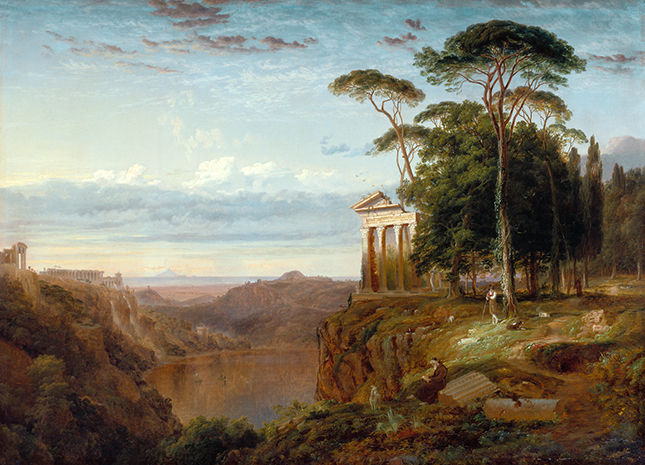
Samuel Lancaster Gerry (American, 1813-1891)
The Lake of Avernus, 1851
Oil on canvas
Museum purchase (75.85)
Height: 69 cm Width: 95 cm
Additional images may be viewed in Argus
Guiding Questions
How might you describe the setting and time period of this painting? What do you see that makes you say that?
Why do you think the artist might have included people in this scene?
About the Art
This painting is an example of Neoclassicism in landscape painting. (For more Neoclassicism see The Bathing Nymphs.) The Lake of Avernus is an actual body of water located eighteen miles west of Mt. Vesuvius (seen in the background at center), near the city of Naples. The lake was considered by the ancient writers such as Vergil and Homer, to be the entrance to the underworld. The various bits of architecture seen in this painting are a combination of real and made up places in Italy. A Franciscan monk, a shepherd, boaters, and a few sheep add life to the scene. The focus of this work, however, is on the landscape itself. The artist used light and atmospheric effects to add depth and give the landscape a sense of grandeur.
About the Artist
Gerry received his artistic training at the National Academy of Design and the Pennsylvania Academy of Fine Arts. This aligned him with the Hudson River School tradition, which shared a belief in the spiritual qualities of the land. When Gerry traveled abroad, he combined European ties to classicism with his Hudson River School background.
Connections
Compare and contrast with The River by Sylvester, who was also associated with the Hudson River School.
Additional Resources
Brief history of the landscape genre from the J. Paul Getty Museum website: http://www.getty.edu/education/teachers/classroom_resources/curricula/la... ground1.html
The Hudson River School, the Metropolitan Museum of Art: http://www.metmuseum.org/toah/hd/hurs/hd_hurs.htm